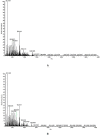A Biodegradable Polyethylenimine-Based Vector Modified by Trifunctional Peptide R18 for Enhancing Gene Transfection Efficiency In Vivo
- PMID: 27935984
- PMCID: PMC5147860
- DOI: 10.1371/journal.pone.0166673
A Biodegradable Polyethylenimine-Based Vector Modified by Trifunctional Peptide R18 for Enhancing Gene Transfection Efficiency In Vivo
Abstract
Lack of capacity to cross the nucleus membrane seems to be one of the main reasons for the lower transfection efficiency of gene vectors observed in vivo study than in vitro. To solve this problem, a new non-viral gene vector was designed. First, a degradable polyethylenimine (PEI) derivate was synthesized by crosslinking low-molecular-weight (LMW) PEI with N-octyl-N-quaternary chitosan (OTMCS), and then adopting a designed trifunctional peptide (RGDC-TAT-NLS) with good tumor targeting, cell uptake and nucleus transport capabilities to modify OTMCS-PEI. The new gene vector was termed as OTMCS-PEI-R18 and characterized in terms of its chemical structure and biophysical parameters. Gene transfection efficiency and nucleus transport mechanism of this vector were also evaluated. The polymer showed controlled degradation and remarkable buffer capabilities with the particle size around 100-300 nm and the zeta potential ranged from 5 mV to 40 mV. Agraose gel electrophoresis showed that OTMCS-PEI-R18 could effectively condensed plasmid DNA at a ratio of 1.0. Besides, the polymer was stable in the presence of sodium heparin and could resist digestion by DNase I at a concentration of 63U DNase I/DNA. OTMCS-PEI-R18 also showed much lower cytotoxicity and better transfection rates compared to polymers OTMCS-PEI-R13, OTMCS-PEI and PEI 25 KDa in vitro and in vivo. Furthermore, OTMCS-PEI-R18/DNA complexes could accumulate in the nucleus well soon and not rely on mitosis absolutely due to the newly incorporated ligand peptide NLS with the specific nuclear delivery pathway indicating that the gene delivery system OTMCS-PEI-R18 could reinforce gene transfection efficiency in vivo.
Conflict of interest statement
The authors have declared that no competing interests exist.
Figures










References
-
- Deng R, Yue Y, Jin F, Chen Y, Kung HF, Lin MC, et al. (2009) Revisit the complexation of PEI and DNA—how to make low cytotoxic and highly efficient PEI gene transfection non-viral vectors with a controllable chain length and structure? Journal of Controlled Release Official Journal of the Controlled Release Society 140: 40–46. 10.1016/j.jconrel.2009.07.009 - DOI - PubMed
-
- Reschel T, Konák C, Oupický D, Seymour LW, Ulbrich K (2002) Physical properties and in vitro transfection efficiency of gene delivery vectors based on complexes of DNA with synthetic polycations. Journal of Controlled Release Official Journal of the Controlled Release Society 81: 201–217. - PubMed
MeSH terms
Substances
LinkOut - more resources
Full Text Sources
Other Literature Sources

